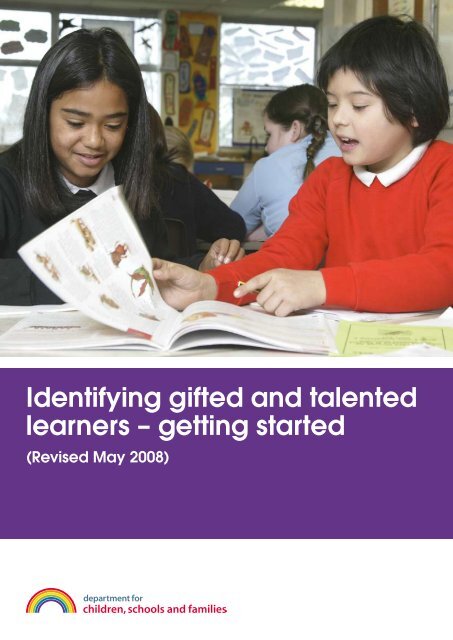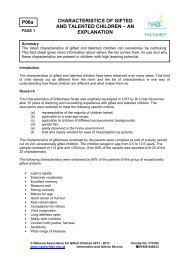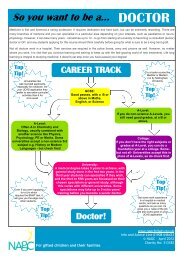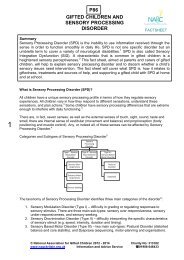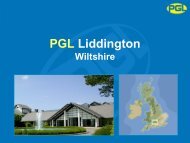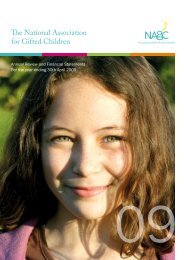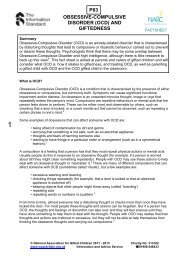Identifying gifted and talented learners – getting started
Identifying gifted and talented learners - Cambridgeshire Education ...
Identifying gifted and talented learners - Cambridgeshire Education ...
- No tags were found...
You also want an ePaper? Increase the reach of your titles
YUMPU automatically turns print PDFs into web optimized ePapers that Google loves.
<strong>Identifying</strong> <strong>gifted</strong> <strong>and</strong> <strong>talented</strong> <strong>learners</strong> <strong>–</strong> <strong>getting</strong> <strong>started</strong> <strong>Identifying</strong> <strong>gifted</strong> <strong>and</strong> <strong>talented</strong><strong>learners</strong> <strong>–</strong> <strong>getting</strong> <strong>started</strong>(Revised May 2008)
This is the second edition of core guidance on the identification of <strong>gifted</strong> <strong>and</strong> <strong>talented</strong><strong>learners</strong>, <strong>and</strong> provides an update to initial guidance published in 2006. It is intended as astarting point for schools; further information can be accessed on the Young Gifted <strong>and</strong>Talented (YG&T) website <strong>and</strong> via the web-links provided at the end of this booklet. In issuingthis guidance we seek to support schools in developing good practice in identification,particularly in relation to under-achieving <strong>gifted</strong> <strong>and</strong> <strong>talented</strong> <strong>learners</strong>, <strong>and</strong> those groupswho are not traditionally well-represented in <strong>gifted</strong> <strong>and</strong> <strong>talented</strong> populations. We are awarethat our collective underst<strong>and</strong>ing of what constitutes ability is still evolving. We are keen toshare effective practice <strong>and</strong> would welcome hearing from schools about strategies youadopt to address issues encountered within your particular context.
<strong>Identifying</strong> <strong>gifted</strong> <strong>and</strong> <strong>talented</strong> <strong>learners</strong> <strong>–</strong> <strong>getting</strong> <strong>started</strong> Government policy onidentification of <strong>gifted</strong> <strong>and</strong><strong>talented</strong> <strong>learners</strong>DCSF defines the group supported by the NationalProgramme for <strong>gifted</strong> <strong>and</strong> <strong>talented</strong> education as:“Children <strong>and</strong> young people with one or more abilities developed to a level significantly ahead of their year group (or with the potential to developthose abilities).”We encourage schools in identifying <strong>gifted</strong> <strong>and</strong><strong>talented</strong> <strong>learners</strong> to focus on:l <strong>learners</strong> aged 11 <strong>–</strong> 19 who meet the publishedeligibility criteria for the top 5% nationally(available at http://ygt.dcsf.gov.uk/Content.aspx?contentId=312&contentType=3)including those who were members of theformer National Academy for Gifted <strong>and</strong>Talented Youth (NAGTY), <strong>and</strong> others whomeet the criteria;l in addition, <strong>learners</strong> aged 4 <strong>–</strong> 19 who are <strong>gifted</strong><strong>and</strong> <strong>talented</strong> relative to their peers in their ownyear group <strong>and</strong> school/college;l a range of abilities including talent in the arts<strong>and</strong> sport; <strong>and</strong>l ability rather than achievement, so thatunderachievers are amongst those identified.There are <strong>gifted</strong> <strong>and</strong> <strong>talented</strong> <strong>learners</strong> in everyyear group in every school/college. All institutionsare free to determine the size of their <strong>gifted</strong><strong>and</strong> <strong>talented</strong> populations, but should be able tojustify this in terms of improved st<strong>and</strong>ards for all<strong>learners</strong> identified. Every school/college shouldhave some <strong>gifted</strong> <strong>and</strong> <strong>talented</strong> <strong>learners</strong> <strong>and</strong> shouldkeep a register of those <strong>learners</strong>. Since relativeability changes over time, <strong>learners</strong> should moveon <strong>and</strong> off the register when appropriate, thoughsuch movement might be expected to reducewith age. Since ability is evenly distributedthroughout the population, a school’s orcollege’s <strong>gifted</strong> <strong>and</strong> <strong>talented</strong> population shouldbe broadly representative of the whole learnerpopulation in terms of gender, ethnic <strong>and</strong>socio-economic background.This guidance booklet:l starts from the principle that there is no singleperfect instrument for identification <strong>–</strong>institutions are advised to use a ‘best fit’ modelthat draws on a range of evidence includingqualitative <strong>and</strong> quantitative elements;l argues that identification <strong>and</strong> provision areinseparable, because identification includesspotting potential through participation inlearning opportunities; <strong>and</strong>l envisages a continuous cyclical process ofidentification <strong>and</strong> review rather than aone-off process.The National Register <strong>–</strong> first announced in the 2005White Paper ‘Higher St<strong>and</strong>ards: Better Schools forAll’ <strong>–</strong> is an amalgamation of all maintained schools’<strong>gifted</strong> <strong>and</strong> <strong>talented</strong> registers (submitted throughSchool Census returns) <strong>and</strong> Key Stage results.Over time, it will develop to:llenable analysis of the national <strong>gifted</strong> <strong>and</strong><strong>talented</strong> population <strong>–</strong> or any subset of it <strong>–</strong> byreference to all data held in the National PupilDatabase <strong>and</strong> the database of the YG&T LearnerAcademy; <strong>and</strong>support the identification of <strong>learners</strong> who arenot currently part of their school’s <strong>gifted</strong> <strong>and</strong><strong>talented</strong> population though they might beperforming at broadly the same level.
<strong>Identifying</strong> <strong>gifted</strong> <strong>and</strong> <strong>talented</strong> <strong>learners</strong> <strong>–</strong> <strong>getting</strong> <strong>started</strong>The Institutional Quality St<strong>and</strong>ards (IQS)The Institutional Quality St<strong>and</strong>ards (IQS) are designed to support schools through a cyclical process ofself-review <strong>and</strong> planning to improve the various aspects of <strong>gifted</strong> <strong>and</strong> <strong>talented</strong> provision, includingidentification. Below are the st<strong>and</strong>ards that apply specifically to identification. The IQS is a self-evaluationtool, which links well with the self-evaluation form (SEF) <strong>and</strong> whole school improvement. It is based on the5 elements of the Personalisation Framework with 14 themes <strong>and</strong> three 3 levels of competence to assistschools in self-diagnosis.lllEntry level is pitched to be within the reach of almost all schools <strong>–</strong> satisfactory.Developing level is designed for schools working towards exemplary provision <strong>–</strong> good.Exemplary level is demonstrating excellent practice <strong>–</strong> outst<strong>and</strong>ing.Entry l The school/college has learning conditions <strong>and</strong> systems to identify <strong>gifted</strong> <strong>and</strong><strong>talented</strong> pupils in all year groups <strong>and</strong> an agreed definition <strong>and</strong> sharedunderst<strong>and</strong>ing of the meaning of ‘<strong>gifted</strong> <strong>and</strong> <strong>talented</strong>’ within its own, local <strong>and</strong>national contexts.l An accurate record of the identified <strong>gifted</strong> <strong>and</strong> <strong>talented</strong> population is kept<strong>and</strong> updated.l The identified <strong>gifted</strong> <strong>and</strong> <strong>talented</strong> population broadly reflects the school/college’ssocial <strong>and</strong> economic composition, gender <strong>and</strong> ethnicity.Developing l Individual pupils are screened annually against clear criteria at school/college <strong>and</strong>subject/topic level.l The record is used to identify under-achievement <strong>and</strong> exceptional achievement(both within <strong>and</strong> outside the population) <strong>and</strong> to track/review pupil progress.l Identification systems address issues of multiple exceptionality (pupils withspecific gifts/talents <strong>and</strong> special educational needs).Exemplary l Multiple criteria <strong>and</strong> sources of evidence are used to identify gifts <strong>and</strong> talents,including through the use of a broad range of quantitative <strong>and</strong> qualitative data.l The record is supported by a comprehensive monitoring, progress planning <strong>and</strong>reporting system which all staff regularly share <strong>and</strong> contribute to.l Identification processes are regularly reviewed <strong>and</strong> refreshed in the light of pupilperformance <strong>and</strong> value-added data. The <strong>gifted</strong> <strong>and</strong> <strong>talented</strong> population is fullyrepresentative of the school/college’s population.Classroom Quality St<strong>and</strong>ards (CQS)A set of Classroom Quality St<strong>and</strong>ards (CQS) is available to support classroom practitioners in developingeffective provision, including teaching <strong>and</strong> learning strategies which support the identification of <strong>gifted</strong><strong>and</strong> <strong>talented</strong> <strong>learners</strong>.
<strong>Identifying</strong> <strong>gifted</strong> <strong>and</strong> <strong>talented</strong> <strong>learners</strong> <strong>–</strong> <strong>getting</strong> <strong>started</strong> Institution-wide identification processesIdentification should be an on-going process, feeding directly into the planning of personalised provision for<strong>learners</strong>. It will also, however, need to feed into the annual review of policy <strong>and</strong> practice <strong>and</strong> be an integralpart of the wider school improvement cycle. The flow chart below shows how this might happen. (See alsoPrompts for Identification within the Classroom on page 8).1Agree principles <strong>and</strong> methods of identification to beused across the school.How will you involve <strong>learners</strong> <strong>and</strong> parents /carers inthis process?2Establish systems for logging <strong>and</strong> tracking the schoolcohort: a school register.What proportion of <strong>learners</strong> will be on the register?How <strong>and</strong> when will information be shared with staff,<strong>learners</strong> <strong>and</strong> parents/carers?12Review identification methods <strong>and</strong> systems <strong>and</strong>plan any adjustments.3Provide CPD for all staff to support rigorous,consistent <strong>and</strong> transparent processes.11Identify strategies to address barriers, plan actionsteps <strong>and</strong> allocate resources.Is training part of induction for new staff?10Evaluate current provision <strong>and</strong> identify barriersto under-representation or underachievement.4Use a range of methods to identify G&T <strong>learners</strong>widely across all areas of learning within <strong>and</strong> beyondthe school.How is information passed on <strong>and</strong> used at transition points?5Populate the school register to include:• the school cohort; <strong>and</strong>• <strong>learners</strong> aged 11 <strong>–</strong> 19 in the top 5% of ability nationally.9Analyse learner performance using school data,RAISEonline.Are all groups in the total school population adequatelyrepresented on the school register?Are there signs of underachievement of individualsor groups?Does individual pupil data indicate previously unidentifiedG&T <strong>learners</strong>?How will you inform parents <strong>and</strong> pupils of inclusion onthe Register?6Identify the needs of the cohort <strong>and</strong> developopportunities to meet these, both within theclassroom <strong>and</strong> beyond.• Lead G&T Coordinator to register with the YG&TLearner Academy.How are pupils’ views sought in identifying their needs?87Indicate those <strong>learners</strong> who are on the schoolregister in termly school census returns,currently January, May <strong>and</strong> September.Establish links with YG&T:• Encourage <strong>learners</strong> to register as members of theLearner Academy.• Support members in accessing provision.
<strong>Identifying</strong> <strong>gifted</strong> <strong>and</strong> <strong>talented</strong> <strong>learners</strong> <strong>–</strong> <strong>getting</strong> <strong>started</strong>General characteristics of <strong>gifted</strong><strong>and</strong> <strong>talented</strong> <strong>learners</strong>The following characteristics (taken from the 1998Ofsted review of research by Joan Freeman) are notnecessarily proof of high ability but they may alertteachers to the need to enquire further into anindividual’s learning patterns <strong>and</strong> ability levels.He or she may:llllllllllllllllbe a good reader;be very articulate or verbally fluent for their age;give quick verbal responses (which canappear cheeky);have a wide general knowledge;learn quickly;be interested in topics which one mightassociate with an older child;communicate well with adults <strong>–</strong> often betterthan with their peer group;have a range of interests, some of which arealmost obsessions;show unusual <strong>and</strong> original responses toproblem-solving activities;prefer verbal to written activities;be logical;be self-taught in his/her own interest areas;have an ability to work things out in his/herhead very quickly;have a good memory that s/he can access easily;be artistic;be musical;llllllllllexcel at sport;have strong views <strong>and</strong> opinions;have a lively <strong>and</strong> original imagination/senseof humour;be very sensitive <strong>and</strong> aware;focus on his/her own interests rather than onwhat is being taught;be socially adept;appear arrogant or socially inept;be easily bored by what they perceive asroutine tasks;show a strong sense of leadership; <strong>and</strong>/ornot necessarily appear to be well-behaved orwell liked by others.UnderachievementGifted <strong>and</strong> <strong>talented</strong> underachievers may tend to:lllllhave low self-esteem;be confused about their development <strong>and</strong>about why they are behaving as they are;manipulate their environment to makethemselves feel better;tend towards a superior attitude to thosearound them; <strong>and</strong>find inadequacy in others, in things, in systems,to excuse their own behaviours.Sometimes those with abilities in one or more areasof learning may also suffer from a disability ordifficulty in others. This can present a considerablebarrier to the achievement of potential, as wellas leading to frustration <strong>and</strong> disaffection.Developing strategies <strong>and</strong> approaches tocountering underachievement should be anintegral part of the school policy for <strong>gifted</strong><strong>and</strong> <strong>talented</strong> provision. The key aspects ofunderachievement that need to be taken intoaccount <strong>and</strong> considered are:llllWhat are the indicators of underachievement?What are the causes of underachievement?What are some ways of counteringunderachievement?Are there potential causes due to dual ormultiple exceptionalities?
<strong>Identifying</strong> <strong>gifted</strong> <strong>and</strong> <strong>talented</strong> <strong>learners</strong> <strong>–</strong> <strong>getting</strong> <strong>started</strong> Identification methodsSchools have the discretion to decide how best toidentify their <strong>gifted</strong> <strong>and</strong> <strong>talented</strong> pupils but arelikely to obtain the best results by drawing on awide range of information sources, including bothqualitative <strong>and</strong> quantitative information. A range ofpopular methods for identification are listed below.1 Teacher/staff nomination2 Checklists3 Testing- achievement, potential <strong>and</strong>curriculum ability4 Assessment of children's work5 Peer nomination6 Parental information7 Discussions with children/young people8 Using community resourcesMethods can differ between age phases <strong>and</strong>between different subjects. The QCA providesdetailed guidance to support assessment indifferent subject areas <strong>and</strong> this is a useful startingpoint for schools to develop their approaches toidentifying <strong>and</strong> supporting <strong>gifted</strong> <strong>and</strong> <strong>talented</strong><strong>learners</strong>, both within <strong>and</strong> across the curriculum.<strong>Identifying</strong> the top 5% of theability range nationally insecondary schools <strong>and</strong> collegesAlthough the criteria for identification of this subsetof <strong>learners</strong> are currently being reviewed, the currentversion remains in force. The new criteria will beavailable on the YG&T website from Autumn 2008.Schools may also find useful the list of their <strong>learners</strong>attaining the highest combined SATs raw scores inMathematics <strong>and</strong> English at KS2, available throughthe Keys to Success website.Care should be taken to ensure that identificationl reflects ability, rather than achievement;l includes talent areas; <strong>and</strong>l does not unduly disadvantage any groupof <strong>learners</strong>, including those from lowersocio-economic backgrounds, children incare, children with special educational needs<strong>and</strong> particular ethnic or gender groups.
<strong>Identifying</strong> <strong>gifted</strong> <strong>and</strong> <strong>talented</strong> <strong>learners</strong> <strong>–</strong> <strong>getting</strong> <strong>started</strong> From identification to provisionNationalProvisionRegionally or LAbased coachingRegionally or LAbased enrichmentCross-school enrichment,extension <strong>and</strong> accelerationClassroom provisionllllllearning activities in the classroom which offeradditional stretch through a combination ofacceleration, enrichment <strong>and</strong> extension;opportunities for independent learning, <strong>and</strong>use of a range of learning styles;learning in settings beyond the classroom,for example in real-life contexts which supportproblem-solving <strong>and</strong> application of knowledge<strong>and</strong> skills;support in specific areas, for example throughlanguage support or mentoring, alongsideincreased challenge in areas of strength; <strong>and</strong>above all, a rich provision for all, which providesfurther opportunities for identification.The Primary Framework for literacy <strong>and</strong>mathematics <strong>and</strong> the renewed SecondaryFrameworks provide support for planning <strong>and</strong>provision to ensure challenge in the classroom.The above diagram sets out the layers of provisionfor <strong>gifted</strong> <strong>and</strong> <strong>talented</strong> children/young people.Stretch <strong>and</strong> challenge for <strong>gifted</strong> <strong>and</strong> <strong>talented</strong><strong>learners</strong> in every classroom is absolutely critical.Providers at this level <strong>and</strong> at others should considerwhat is available at the next layer of provision thatmight benefit the learner. Once an individual hasbeen identified there should be support availablethrough the levels of the pyramid. Nationalprovision is available for all identified <strong>learners</strong>through the YG&T Learner Academy. Their websitealso provides links to a regional layer of provision,including Excellence Hubs.Personalisation: fromidentification to practicePersonalised learning is about tailoring educationto individual need, interest <strong>and</strong> aptitude so as toensure that every learner achieves <strong>and</strong> reaches thehighest st<strong>and</strong>ards possible, notwithst<strong>and</strong>ing theirbackground or circumstances. For <strong>gifted</strong> <strong>and</strong><strong>talented</strong> <strong>learners</strong> this includes:leffective assessment for learning, so thatplanning takes account of prior learning,stretching curricular targets are set with pupils,<strong>and</strong> differentiated learning objectives <strong>and</strong>outcomes are shared;
<strong>Identifying</strong> <strong>gifted</strong> <strong>and</strong> <strong>talented</strong> <strong>learners</strong> <strong>–</strong> <strong>getting</strong> <strong>started</strong>Prompts for identification within the classroomThis diagram is intended to support classroom practitioners in identifying <strong>gifted</strong> <strong>and</strong> <strong>talented</strong> <strong>learners</strong>.The processes in it will feed into <strong>and</strong> should be informed by those in the Institution-wide IdentificationCycle. Whilst it demonstrates one possible routeway, identification is not a linear process <strong>and</strong> practitionersshould continuously be on the look-out for indications of high ability <strong>and</strong> previously undiscoveredpotential in the classes they teach. They will need to plan a range of opportunities which allow <strong>learners</strong> todemonstrate ability or potential ability.StartHas the learner been identified by his/her previousschool or teacher?Check transfer records.Ensure that planning takes account of <strong>learners</strong>’needs <strong>and</strong> interests, offering challenge within theclassroom <strong>and</strong> access to out-of-school opportunitiesthat are available locally, regionally <strong>and</strong> nationally.Provide opportunities for pupils to demonstratehigh performance <strong>and</strong> scan regularly for indicationsof potential.Does the learner demonstrate any particular abilities<strong>and</strong> interests through activity which s/he takes partin out of school?Provide additional support <strong>and</strong> encouragement forunderachievers whilst ensuring that learning targets<strong>and</strong> activities are sufficiently challenging.Use learner/parent questionnaires, review days,parents meetings to find out about out-of-schoolinterests <strong>and</strong> activities.Tap into sources of support for underachievement,such as expertise within <strong>and</strong> beyond the school,mentoring, etc.Does performance within the classroom or outsidesuggest that the learner has ability within the top5% nationally (secondary schools)?Consult criteria on the YG&T website.Does the learner occasionally or inconsistentlydemonstrate high performance, <strong>and</strong>/orcharacteristics of G&T underachievers?Are there any factors which might mask thislearner’s ability or hamper consistent achievement?Is performance in recent formal tests eg. SATs, CATs<strong>and</strong>/or teacher assessment significantly higher thanthat of others in the class?Does the learner demonstrate a number ofcharacteristics or behaviours of <strong>gifted</strong> <strong>and</strong> <strong>talented</strong>children/young people?Some key questions to help with identificationSome pointers towards provision
<strong>Identifying</strong> <strong>gifted</strong> <strong>and</strong> <strong>talented</strong> <strong>learners</strong> <strong>–</strong> <strong>getting</strong> <strong>started</strong> Web links to get <strong>started</strong>The Young Gifted <strong>and</strong> Talented website providesresources <strong>and</strong> guidance for educators, a portal toother sites, <strong>and</strong> access to a wide range of provisionfor members of the Learner Academy.www.ygt.dcsf.gov.uk/l<strong>and</strong>ing.aspxThe National Strategies e-learning module onidentification can be accessed in their CPDlearning environment.www.nationalstrategiescpd.org.uk/course/view.php?id=81The Youth Sports Trust provides information onidentifying <strong>and</strong> developing talent in sport on theTalent Matters website.www.talentmatters.org/Creative Generation provides a starting point forguidance on talent identification in the performingarts. This is hosted on the YG&T site.http://ygt.dcsf.gov.uk/Content.aspx?contentId=185&contentType=3QCA <strong>–</strong> guidance on subject identification.http://www.nc.uk.net/gt/Gifted <strong>and</strong> <strong>talented</strong> education guidance onpreventing underachievement: a focus on dual ormultiple exceptionalities (DME).http://publications.teachernet.gov.uk/default.aspx?PageFunction=productdetails&PageMode=publications&ProductId=DCSF-00052-2008<strong>and</strong>http://www.st<strong>and</strong>ards.dfes.gov.uk/primary/publications/inclusion/pns_gift_talent_dme_0006107/Gifted <strong>and</strong> Talented Education: Helping to find <strong>and</strong>support children with dual or multiple exceptionalities.http://publications.teachernet.gov.uk/default.aspx?PageFunction=productdetails&PageMode=publications&ProductId=DCSF-00052-2008<strong>and</strong>http://www.st<strong>and</strong>ards.dfes.gov.uk/primary/publications/inclusion/gt_findsuportdme/Gifted <strong>and</strong> Talented Education Guidance onpreventing underachievement: a focus on children<strong>and</strong> young people in care.http://www.st<strong>and</strong>ards.dfes.gov.uk/primary/publications/inclusion/gt_children_in_care/Gifted <strong>and</strong> Talented Education <strong>–</strong> Guidance onpreventing underachievement: a focus onexceptionally able pupils.http://www.st<strong>and</strong>ards.dfes.gov.uk/secondary/keystage3/all/respub/gt_prevent_udrachieve0006608Primary Framework for literacy <strong>and</strong> mathematics.http://www.st<strong>and</strong>ards.dfes.gov.uk/primaryframeworks/The renewed Secondary Frameworks.http://www.st<strong>and</strong>ards.dcsf.gov.uk/secondary/
This booklet along with more extensive informationabout identification can be found on the Young Gifted<strong>and</strong> Talented website www.ygt.dcsf.gov.uk/You can also download this publication or order copiesonline at: www.teachernet.gov.uk/publicationsSearch using the ref: 00367-2008You can also download this publication atwww.dcsf.gov.uk/ygtCopies of this publication can also be obtained from:DCSF PublicationsPO Box 5050Sherwood ParkAnnesleyNottingham NG15 ODJTel 0845 60 222 60Fax 0845 60 333 60Textphone 0845 60 555 60Please quote ref: 00367-2008BKT-ENISBN: 978-1-84775-151-5PPDUD/D35(3840)/0508/14© Crown Copyright 2008Published by the Department forChildren, Schools <strong>and</strong> FamiliesExtracts from this document may be reproducedfor non-commercial research, education or trainingpurposes on the condition that the source isacknowledged. For any other use please contacthmsolicensing@opsi.x.gsi.gov.uk


